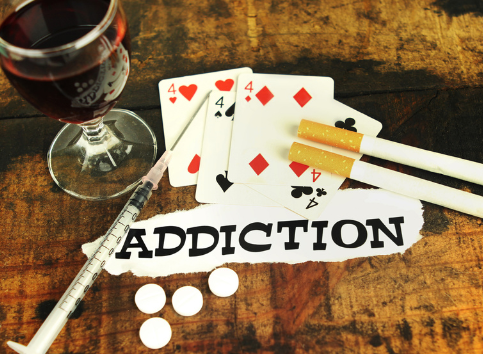How to spot an addiction using the five Cs
Published 9 Mar 2024 • By Candice Salomé
Addiction is characterised by the repeated consumption of a substance, such as tobacco, alcohol or drugs, or by the abnormally excessive practice of a potentially harmful behaviour (gambling, social networking, etc.).
It is not always easy to realise that you have developed an addiction, as there is an element of denial in being addicted to or dependent on something. In his book "Say goodbye to addiction!", Laurent Karila, a psychiatrist specialising in addictions, suggests using the concept of the five Cs as a way of identifying the main signs and symptoms of addiction.
So what exactly is an addiction? How can addiction to something affect our health? And what is the concept of the five Cs?
We explain it all in our article!

What is addiction?
Addiction is a cerebral condition characterised by a dependence on a substance or activity, with negative consequences for the person's daily life and deterioration of their quality of life.
Addictions may develop to:
- regulated psychoactive substances (tobacco, alcohol, etc.),
- psychoactive substances when they are used in a way other than initially intended by their manufacturers (medicines, poppers, glues, solvents, etc.),
- illegal psychoactive substances (cannabis, cocaine, ecstasy, etc.),
- certain practices such as gambling, video games, sex, social networking or compulsive shopping.
There are three stages in the development of an addiction:
Searching for pleasure (stage 1)
When you consume a psychoactive substance, or are involved in a certain addictive activity, your cerebral reward circuit is activated. It is dependent on dopamine. By repeating the consumption/activity, you can become conditioned to receiving a reward and discharges of dopamine are progressively released in anticipation, predicting the arrival of the reward.
At the same time, other neurotransmission systems (serotonin and endorphins) are modified: they become less sensitive to the endogenous molecules normally involved in analgesia and the sensation of well-being. The natural production of endorphins decreases.
From this point onwards, pleasure becomes only possible through the addictive substance, which leads to the development of tolerance to this substance and a feeling of withdrawal as soon as you stop consuming it.
Negative emotional state (stage 2)
In this second stage, the level of dopamine released with each consumption gradually decreases, making the reward circuit much less sensitive to the molecules that usually stimulate it.
In addition, repeated discharges of dopamine tend to alter the functioning of the brain's amygdala, making you more stressed, and filling you with negative emotions.
Moreover, what used to give you pleasure becomes less motivating. Only an increase in the dose of the substance or the frequency of the activity you are addicted to can satisfy the reward circuit and free you from the negative emotions.
Gradually, the fact of consuming the substance or doing the activity you are addicted to only allows you to get out of this negative emotional state but it no longer brings you satisfaction.
Loss of control (stage 3)
At this point, the reward circuits are so altered and the emotions so negative that certain processes controlled by the prefrontal cortex are modified. These processes include self-regulation, decision-making and the ability to resist the urge to do what you are addicted to.
At this stage, relapses are frequent, even if the desire to overcome the addiction is strong.
What are the dangers of being addicted?
Addiction has many negative consequences for those affected. The most common and well-known ones are specific to the addiction and appear immediately: euphoria, disinhibition, loss of control, etc. They vary according to the nature of the addictive substance or activity. There is also a life-threatening risk associated with the use of certain substances: overdose, alcoholic coma, etc.
Addiction also impacts behaviour: when it takes over a person's daily life, it can have harmful effects on their professional and family life and their relationships.
Finally, addiction can affect your health, both mental and physical. For example, it can cause memory and attention problems, it can make make you more impulsive, and lead to the development of mood disorders, which gradually set in.
Certain complications also arise, such as a risk of cardiovascular disease or cancer (with the use of tobacco, for example), or a risk of a cognitive condition or a tumour (through alcohol abuse), as well as neurological and psychiatric disorders (with the use of illegal drugs), and contamination by HIV, HBV or HCV ( through injecting drugs).
How to spot an addiction using the concept of the five Cs?
In his book "Say goodbye to addiction!", Laurent Karila, a psychiatrist and addiction specialist, suggests using the concept of the five Cs of addiction:
- Control (loss of control),
- Consumption (irrepressible urge to use a certain substance or engage in a certain activity),
- Compulsion (compulsive activity),
- Continuous (ongoing use),
- Consequences (continued use despite negative consequences).
This concept can help spot the signs and symptoms of an addiction in someone you love, or in yourself, become aware of it and seek help from a healthcare professional. Getting help is vital, as addiction implies lack of independence and freedom, which makes it difficult for those who are addicted to something to overcome it by themselves.
Conclusion
Addiction initially involves repeated consumption of a substance or repetition of a certain activity. It is accompanied by the gradual onset of withdrawal and/or dependency. The person then loses control over their free will, and is seized by an irrepressible urge, or craving, to consume the substance or engage in the activity again and again. They continue doing so even though they are well aware of all the medical, psychological and social risks that are involved. This is called denial, one of the signs of addiction.
Take care!

 Facebook
Facebook Twitter
Twitter


